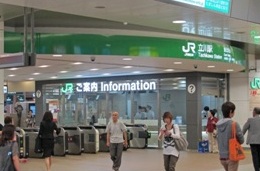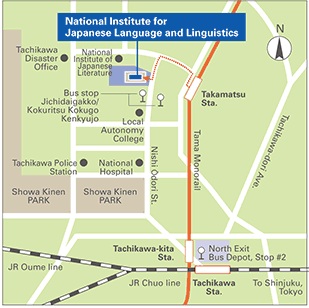Venue & maps
Getting to Tachikawa
Tokyo Airports
Most international flights to Tokyo arrive at Narita Airport (http://www.narita-airport.jp/en/), but there has recently been an increase in service to Haneda Airport (http://www.haneda-airport.jp/en/). NINJAL (the site of the workshops) is located in the city of Tachikawa, which is a long distance from either airport.
Narita to Tachikawa
There are two options for getting from Narita Airport to Tachikawa.
by train
If you have purchased a Japan Rail Pass so that you can travel around by train before or after the conference, you can exchange your voucher for the actual pass at the JR East (East Japan Railway Company) station in the airport and take the Narita Express (http://www.jreast.co.jp/e/nex/narita.html).
There are two trains a day that will take you all the way to Tachikawa. They leave Narita Airport Terminal 1 at 19:45 and at 21:49. If you do not have a rail pass, this trip will cost ¥3,980.
If you are not able to take one of these two trains, you will have to take the Narita Express from the airport to Shinjuku (http://www.jreast.co.jp/e/stations/e866.html). At Shinjuku, it will be necessary to transfer to an outbound Chūō Line commuter train. All outbound trains stop at Tachikawa. If you do not have a rail pass, this trip will cost ¥3,550.
Please note:The Chūō Line is one of the most heavily used train lines in Japan, and the outbound trains are extremely crowded from mid afternoon until late at night. It will take at least 25 minutes to get from Shinjuku to Tachikawa, and you are very unlikely to find a seat. Also, it can be quite a challenge just to get on and off the train if you have a suitcase.
by bus
For most people, especially those with luggage, the Airport Limousine bus (http://www.limousinebus.co.jp/en/platform_searches/index/2/101#reserve) is a better option. The ticket counters are located just outside the exits from Customs and Immigration. There are 9 trips a day to Tachikawa, and the fare is ¥ 3,500. The last departure each day is at 20:20–20:30 (depending on which of the three airport stops you board at). The trip typically takes about 2½ hours, but it varies considerably depending on traffic conditions. When you buy your ticket, the clerk will ask you where you want to get off. Choose either Tachikawa Station/Grand Hotel (the first stop) or Palace Hotel (the second stop), depending on where you are staying. Unless you are staying at the Palace Hotel, the first stop will probably be better, but be aware that it is actually quite a distance (about 300m) from Tachikawa Station.
Haneda to Tachikawa
There are two options for getting from Haneda Airport to Tachikawa.
by train
Unless you are familiar with the Tokyo commuter train network and do not have much luggage, we do not recommend traveling from Haneda to Tachikawa by train. The easiest route is to take the Tokyo Monorail (http://www.tokyo-monorail.co.jp/english/) from the airport to Hamatsu-chō, the JR East Yamanote Line or Keihin-Tōhoku Line from Hamatsu-chō to Tokyo Station, and the JR East Chūō Line from Tokyo Station to Tachikawa.
by bus
The Airport Limousine bus (http://hnd-bus.com/route/haijima.html) is the recommended option. The airport ticket counter is located just outside the exit from Customs and Immigration. There are 20 trips a day to Tachikawa, and the fare is ¥ 1,500. The last departure each day is at 10 minutes past midnight. The trip typically takes a little less than 2 hours, but it varies considerably depending on traffic conditions. When you buy your ticket, the clerk will ask you where you want to get off. Choose either Tachikawa Railway Station (the first stop) or Palace Hotel (the second stop), depending on where you are staying. Unless you are staying at the Palace Hotel, the first stop will probably be better.
Finding your hotel
If this is your first trip to Japan, the area around a major railway station like Tachikawa may feel like a maze, especially if you arrive after dark. Your hotel’s website should include a map that will help you to find your way, but if you get lost, almost anyone you approach will try to help you. Try to speak English slowly and clearly (although you might be lucky enough to run into someone who is highly proficient). People who work in convenience stores (7-Eleven, Lawson, Family Mart, Sunkusu, etc.) usually know the area well. If necessary, you can ask for directions at the police box near the Krispy Kreme on the north side of Tachikawa Station (ground level) or at the information counter inside Tachikawa Station (located upstairs near the ticket gates).


Police box Information center
Getting from Tachikawa Station to NINJAL
NINJAL
The National Institute for Japanese Language and Linguistics (NINJAL) is the host for J/K22. NINJAL is located about 1.5km north of Tachikawa Station. You can get from Tachikawa Station to NINJAL on foot, by bus, by monorail, or by taxi.

On foot
October is arguably the nicest time of year in Tokyo. The average high temperature is about 17° (63° F), the average low temperature is about 10° (50° F), and the probability of a rainy day is only about 25%. On a nice day, the easy 20-minute walk from Tachikawa Station to NINJAL is very pleasant. [walking directions]
Bus
Buses run frequently between Tachikawa Station and NINJAL, and the ride takes about 5 minutes. There is a bus stop right in front of NINJAL. The bus is probably the best option on a rainy day, but it is not to easy to use if you do not know Japanese, so please follow the instructions provided. The fare is ¥190. [bus directions]
Monorail
The Tama Monorail stops both on the south side and on the north side of Tachikawa Station. The closest monorail station to NINJAL is Takamatsu, and the ride takes about 2 minutes from Tachikawa-kita (the Monorail station the north side of Tachikawa Station). However, it takes about 7 minutes to walk from Takamatsu station to NINJAL. Please follow the instructions provided. The fare is ¥100. [monorail directions]
Taxi
There is a taxi stand on the on the north side of Tachikawa Station near the Stabucks on the gound level. The minimum fare of ¥710 should be enough to get you from there to NINJAL. You can also catch a taxi on the south side of Tachikawa Station, but it will take quite a bit longer and cost more because the driver will have to take a circuitous route to get under the train tracks. A single taxi is big enough to carry 3 people comfortably, and it is usually possible squeeze in 4 people, with one passenger in the front seat. The driver pushes a button to automatically open the and close the left rear door (where passengers normally get in and out), and passengers are not supposed to open or close this door themselves. Most drivers do not speak English, but they will understand if you say “Receipt, please.” On the other hand, “NINJAL” will mean nothing to a taxi driver, so if you plan to take a taxi, you should print out the taxi directions provided so that you can show them to your driver. [taxi directions]
